

The dart frogs. The dart frogs are real jewels of the nature a lot of people dream of.
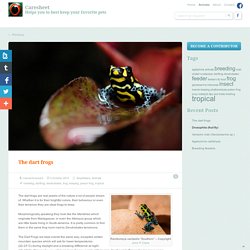
Whether it is for their brightful colors, their behaviour or even their terrarium they are ideal frogs to keep. Morphologically speaking they look like the Mantellas which originate from Madagascar, or even the Atelopus group which are little toads living in South-America. It is pretty common to find them in the same frog room next to Dendrobates terrariums. The Dart Frogs are kept overall the same way, excepted certain mountain species which will ask for lower temperatures (22-23°C) during daylight and a breaking difference at night (15-18°C). This is why you will learn here the key points of their care. Description Phyllobates bicolor, one of the 3 dangerous ones – Copyright leeinhisroom Some poisonous frogs? Being called “poison dart frogs” and often shortened as “dart frogs”, you might have a part of an answer already. The 3 dangerous species : Phyllobates bicolor, Phyllobates terribilis, Phyllobates aurotaenia. ).
Des grenouilles pour ensoleiller ma journée! Elles sont là, spectaculaires, fascinantes!
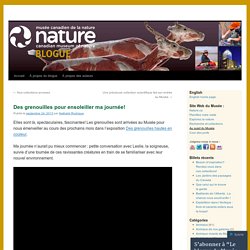
Les grenouilles sont arrivées au Musée pour nous émerveiller au cours des prochains mois dans l’exposition Des grenouilles hautes en couleur. Ma journée n’aurait pu mieux commencer : petite conversation avec Leslie, la soigneuse, suivie d’une tournée de ces ravissantes créatures en train de se familiariser avec leur nouvel environnement. Cette vidéo vous montre l’installation de plusieurs espèces de grenouilles dans leur nouvel habitat. La soigneuse Leslie Thompson les compte (en anglais) en même temps qu’elle les relâche de leur contenant. Vidéo : Daniel Boivin © Musée canadien de la nature Les terrariums reconstituent les habitats des grenouilles. Après avoir été enfermées dans des boîtes pendant presque 48 heures et effectué le voyage de 12 heures de la Pennsylvanie jusqu’ici en compagnie de leur soigneuse, ces grenouilles sont sans doute heureuses de retrouver leurs cascades d’eau fraîche ou leurs bromélias.
Apisto-home Article. Italian translation at vergari.com Reprint from Germany’s Datz Magazine, May 2001 ;English translation published in the Apisto-Gram Volume 19 No.4 Issue# 77 December 2002 AMAZONIAN JUNGLE IN THE NATIONAL AQUARIUM The National Aquarium in Baltimore, Maryland (NAIB) has an Amazon tropical rain forest exhibit under its futuristic glass roof for over 20 years now, including it’s habitants.
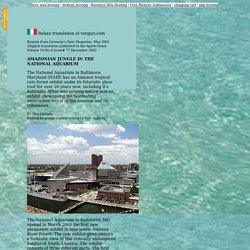
What was missing before was an exhibit showcasing the fascinating underwater world of the Amazon and its tributaries. By Max Gallade English language content edited by Lois Gallade The National Aquarium in Baltimore, MD opened in March 2000 the first new permanent exhibit in nine years: Amazon River Forest. The new exhibit gives visitors a fantastic view of this critically endangered habitat of South America.
The exhibit consists of three different parts. The first part, the main exhibit shows a 57 foot stretch of a typical Amazon tributary at the beginning of the rainy season. Allpahuayo Mishana. Dendrobates auratus. Account by Thomas Ostrowski Distribution This Central American species occurs from southeastern Nicaragua to northwestern Colombia.
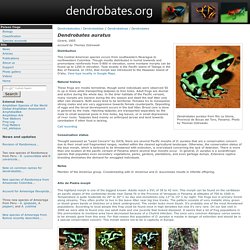
Though mostly distributed in humid lowlands and premontane rainforests from 0-800 m elevation, some montane morphs can be found up to 1200 m elevation. Type locality is the Pacific island of Taboga in the Bay of Panamá. In 1932, that morph was introduced to the Hawaiian Island of O’ahu. Natural history These frogs are mostly terrestrial, though some individuals were observed 50 m up in trees while transporting tadpoles to tree holes. Call recording Conservation status Thought assessed as “Least Concern” by IUCN, there are several Pacific morphs of D. auratus that are a conservation concern due to their small and fragmented ranges, nestled within the cleared agricultural landscape. Notes Member of the tinctorius group. Alto de Piedra morph This highland morph is one of the biggest known. Caldera morph Taboga morph. Distribution Near the town of Santa Rosa in the Cordillera del Condor, northwestern Peru, 950 – 1250 m elevation.
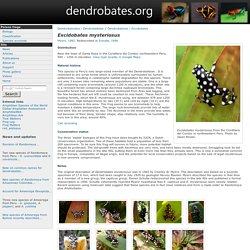
View type locality in Google Maps. Natural history This species is Peru’s only large-sized member of the Dendrobatinae . It is restricted to dry scrub forest which is unfortunately surrounded by human settlements, resulting in catastrophic habitat degradation for this species. Call recording Conservation status The three ‘stable’ biotopes of this frog have been bought by IUCN, a Dutch conservation organization. Notes The original description of Dendrobates mysteriosus was in 1982 by Charles W.